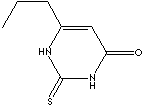PRODUCT IDENTIFICATION

H.S. CODE
TOXICITY
CLASSIFICATION
Antimetabolite, Antithyroid, Hormone Substitute, Nucleoside Analog, Pyrimidine, Thiourea
EXTRA NOTES
A thiourea antithyroid agent. Propythiouracil inhibits the synthesis of thyroxine and inhibits the peripheral conversion of throxine to tri-iodothyronine. It is used in the treatment of hyperthyroidism. (From Martindale, The Extra Pharmacopeoia, 30th ed, p534)
PHYSICAL AND CHEMICAL PROPERTIES
6.0 - 7.0 at 5 g/l at 20 C
REFRACTIVE INDEX
326 C
Stable under ordinary conditions. Light sensitive
EXTERNAL LINKS & GENERAL DESCRIPTION
Drug Information Portal (U.S. National Library of Medicine) - Propylthiouracil
PubChem Compound Summary - Propylthiouracil
Drug Bank - Propylthiouracil
KEGG (Kyoto Encyclopedia of Genes and Genomes) - Propylthiouracil
http://www.jci.org/
Propylthiouracil
blocks extrathyroidal conversion of thyroxine to triiodothyronine
and augments thyrotropin secretion in man.
http://www.medicinenet.com/
DRUG
CLASS AND MECHANISM: Propylthiouracil (PTU) is an oral medication
that is used to manage hyperthyroidism which is due to an overactive
thyroid gland. It is an anti-thyroid drug that has a mechanism of
action that is similar to methimazole (Tapazole). Graves' disease
is the most common cause of hyperthyroidism. It is an autoimmune
disease where an individual makes antibodies to thyroid stimulating
hormone receptors on cells of the thyroid gland and then trigger
overproduction of thyroid hormone by the cells. The two thyroid
hormones manufactured by the thyroid gland, thyroxine (T4 ) and
triiodothyronine (T3), are formed by combining iodine and a protein
called thyroglobulin with the assistance of an enzyme called peroxidase.
PTU inhibits iodine and peroxidase from their normal interactions
with thyroglobulin to form T4 and T3. This action decreases production
of thyroid hormone. PTU also interferes with the conversion of T4
to T3, and, since T3 is more potent than T4, this also reduces the
activity of thyroid hormones. The FDA approved PTU in July 1947.
Local:
Propylthiouracil is used as an antithyroid drug for the treatment of
hyperthyroidism. It is used in veterinary medicine for antithyroids. Other
antihyroid drugs include alpha thyrotropin, levothyroxine,
L-thyroxine, liothyronine, liotrix, methimazole.
APPEARANCE
ASSAY
98.0 - 100.5%
LOSS ON DRYING
0.5% max
THIOUREA
on request
RESIDUE ON IGNITION
0.1% max
Hazard Overview
OSHA Hazards:Carcinogen, Target Organ Effect, Harmful by ingestion. Target Organs: Thyroid., Liver. May cause respiratory tract irritation. May cause eye and skin irritation. May be harmful if swallowed, inhaled, or absorbed through the skin. Suspect cancer hazard. May adversely affect the developing fetus. Propylthiouracil (PTU) inhibits thyroid activity. EPA requires handling and report/recordkeeping for PTU under RCRA. PTU is a hazardous constituent (Appendix VIII) with no waste number. Target Organs: Blood, liver, thyroid. Potential Health Effects
GHS
PICTOGRAMS


HAZARD STATEMENTS
H302:
Harmful if swallowed
H351: Suspected of causing cancer
PRECAUTIONARY STATEMENTS
P281:
Use personal protective equipment as required
P301+ P312:
IF SWALLOWED: Call a POISON CENTER or doctor/physician if
you feel unwell
![]() Xn
Harmful
Xn
Harmful
RISK PHRASES
22:
Harmful if swallowed.
40: Limited evidence of a carcinogenic
effect.
SAFETY PHRASES
36/37:
Wear suitable protective clothing and gloves.
45: In
case of accident or if you feel unwell, seek medical advice immediately
(show the label where possible).